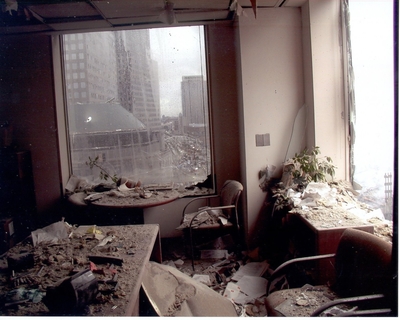The 20th anniversary of the 9/11 terrorist attacks is practically upon us. I’m working on a post about that, of course. In the meantime, I wanted to share a couple of things related to the Wall Street Journal and MrB (aka Paul Steiger, aka the managing editor of the WSJ from 1991 through 2007).
The Wall Street Journal, in its pre-Murdoch days, was headquartered in the World Financial Center office complex (now Brookfield Place), across the street from the World Trade Center. Fortunately, almost everyone evacuated the WSJ offices before the Trade Center’s twin towers collapsed, because the WSJ’s building was heavily damaged.
Even though the newspaper’s New York staffers left everything behind — and many of them were exposed to traumatic sights and sounds of carnage as they fled for their lives — WSJ employees in the city and around the country pulled together to put out the paper as usual on September 12, 2001. The coverage, which later won the Pulitzer Prize for breaking news, was topped by what was then a rare six-column headline, per MrB’s request.
This journalistic achievement was so remarkable that former reporter and author Dean Rotbart interviewed many of the participants, including MrB and even me, for a book called September Twelfth: An American Comeback Story.

I particularly appreciate the kind words editor Cathy Panagoulias had for MrB:
“The magic of that day was that Paul Steiger had spent his entire tenure at the Journal hand-picking and developing a team of editors that performed better for him than they would ever perform without him. …
… So on the morning of September 11, when we couldn’t find him or communicate with him, when we couldn’t communicate with one another, when some of us thought he was dead, we each did our job, knowing the other top editors if they weren’t dead were doing their jobs (and if they were dead their deputies would take over), and somehow we would produce a paper that would make Paul Steiger proud.”
It’s true that MrB outdid himself that day, as did every single member of the staff, but the performance of top editor Joanne Lipman takes the cake. Literally. After escaping a store in the World Trade Center with small gifts for her daughter Rebecca’s 11th birthday, then working on the September 12 edition till 11 p.m., Joanne went home and … wrapped the gifts and baked a birthday cake for Rebecca. I always knew that Joanne was superhuman, but that was a story I’d never heard before. Also new to me in Dean’s book was the cause of the severe health problems suffered by editor Rich Regis after 9/11. Regis, who was with MrB in the debris cloud when Trade Center collapsed, died last summer just short of the age of 68, after being hospitalized and intubated for sepsis-related pneumonia. Incredibly, this final illness had nothing to do with Covid, but was the direct result of 9/11. It’s tragic and compelling reading.
I suggest that journalism aficionados buy the book from Dean’s site, Gutenberg’s Store. If you do it by this Sunday, September 12, and use the coupon code “ProPublica” during checkout, Dean will make a $5 donation to your choice of a worthy journalism-related nonprofit. The options include investigative reporting organization ProPublica, of which MrB was the founding editor. The others are the Committee to Protect Journalists, which is a cause that’s near and dear to me; News Literacy Project; Poynter Institute; the Medill School of Journalism at Northwestern University. The book is also available without the charitable component at that e-commerce monopoly that I loathe; hopefully, it will soon be available at Barnes & Noble too.
For those of you who want to hear a little about September 12 from MrB before your book arrives, you’re in luck: He was interviewed by CNBC today via Zoom. You can also check out my living room.
I insisted on the tie, because the anniversary calls for gravitas. For the same reason, I pushed the cat tree out of the frame. MrB was going to leave it right behind him. SMH!

